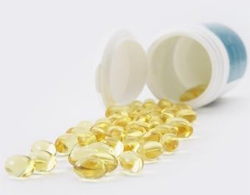
It is believed that in modern conditions, taking into account the poor ecology of the city, unbalanced nutrition, the lack of motor activity The human body is constantly experiencing a lack of vitamins and minerals (differently - hypovitaminosis). Especially acute it is manifested in the winter-spring period. Output can be the reception of multivitamine complexes, a large selection of which you will be offered in any pharmacy. How to understand the huge number of items and decide what is suitable for you? What to pay attention to the acquisition of multivitamins? And so if you need to take them?
What is vitamins
Vitamins are biologically active substances of various chemical nature, which take part in all biochemical processes of the body, and therefore are absolutely necessary for normal human life. Vitamins enroll into our body together with food or produced by intestinal microflora (with the exception of nicotine acid and vitamin D, which in small quantities is synthesized in the skin under the influence of sunlight).
Currently, there are 13 vitamins and about a dozen vitamin-like substances (see. table).
| Vitamin | International name, Vitamera |
| Water soluble vitamins | |
| Vitamin C | Ascorbic acid |
| Tiamine (Vitamin Vone) | Tiamine |
| Riboflavin (Vitamin V2) | Riboflavin |
| Pantothenic acid (vitamin infive) | Pantothenic acid |
| Vitamin B6 | Pyridoxal, pyridoxine, pyridoxamine |
| Vitamin B12 (cobalamines) | Cyanocobalamin, oxycobalamin |
| Folate (Vitamin Vwith) | Folic acid, polyglutamats of folic acid |
| Niacin (vitamin PP) | Nicotinic Acid, Nicotinamide |
| Biotin (vitamin H) | Biotin |
| Fat-soluble vitamins | |
| Vitamin A | Retinol, retinol acetate |
| Vitamin D (calciferols) | Ergocalciferol (Vitamin D2); cholecalciferol (vitamin D3) |
| Vitamin E (tocopherol) | A-, B-, G-, D-Tocopherol |
| Vitamin K | Fillaxinone (Vitamin Kone); Menahanoons (vitamins for2); 2-Metyl-1, 4-Naftoquinone (Menadion, Vitamin K3) |
| Vitamin-like substances | |
| inosit | |
| Vitamin U | S-methylmethionine |
| Vitamin N | Lipoic acid |
| Vitamin B8 | choline |
| Vitamin B10 | Paramyinobenzoic acid |
| Vitaminv 13 | Ortic acid |
| Vitamin Bfifteen | Pangamic acid |
| Vitamin R | Bioflavonoids |
| Carnitin | |
| Coenzyme Q10 | |
Some fat-soluble vitamins (A, D) are replenished due to the splitting of applicants from food provitamins. For example, reittola provitamins (vitamin A) - Carotes. In the multivitamine complexes, provitamin A - beta-carotene is especially used (it has the greatest biological activity), which has already been proven, increases the risk of lung cancer in smokers.
Many vitamins are part of the vitamin complexes in the form of various connections - whitamers, which should also be considered when purchasing multivitamin drugs. For example, vitamin E can be represented by A-, B-, G-, D-tocopherol, A-Tocopherol is the most active.
Just like vitamins, for the work of the body we need and minerals (macro and trace elements). Microelements include calcium, phosphorus, potassium, magnesium, sodium, chlorine present in the body in sufficiently large quantities, to microelements - iron, cobalt, iodine, fluorine, the content of less than 0.01%. With food, we can not always get sufficient volume. Therefore, minerals are often added to multivitamin complexes.
Signs of hypovitaminosis

It is usually about what you lack vitamins will tell the condition of the skin, hair, nails. If your nails have become brittle and dull, hair falls out, dry skin and peeling, often acne appear, Yachna and acne means you have hypovitaminosis. Same Lack of vitamins In the body leads to deterioration of performance, increase fatigue, reduced memory, attention. An irritability appears. The body does not cope with infections, which causes frequent colds. Can start bleeding gums, worsen eyesight (especially in the evening)
The lack of vitamins and trace elements in children is usually manifested by the delay in growth and development. Children become either too sluggish, or vice versa, too exclude. They begin to learn worse, get tired faster, often sick.
Distinguish primary and secondary hypovitaminosis. Primary hypovitaminosis develop with a lack of vitamins in the body due to defective nutrition, diet, bad habits. Secondary hypovitaminosis are a consequence of violations in the operation of the gastrointestinal tract (which reduces the body's ability to absorb vitamins and their development), reinforced diurea (speeds up the removal of vitamins from the body), dysbiosis against the background of antibiotics, increase the need of the body in vitamins due to large loads in the period of growth, pregnancy, lactation.
Do I need to take vitamins
In theory, full-fledged balancing food must fully provide the body with all the necessary vitamins and microelements. However, in practice it turns out that our food is far from perfect, and the products themselves, after processing their chemicals, refining, long-term storage, the preservation is losing more vitamins. Smoking and alcohol use, consumption of many drugs, especially antibiotics, stress, diseases of the gastrointestinal tract - all this leads to a decrease in the number of vitamins and minerals in the body.

Therefore, doctors are often recommended for the prevention of making multivitamin complexes in addition to the daily diet, or by courses for 1-2 months 2-3 times a year.
However, there is a different point of view, based on which the human body can adapt to the lack of vitamins, and in the absence of functional deviations in health, it will be much more useful to organize a full-fledged diet than to solve this problem of the use of vitamin preparations.
Take multivitamins recommended:
- with irregular, monotonous, unbalanced nutrition;
- sitting on strict, low-calorie diets and monodulations;
- with elevated physical and psycho-emotional loads;
- athletes;
- in the postoperative period;
- during illness and during the recovery period after the suffering disease;
- People suffering from chronic diseases;
- vegetarians;
- when receiving hormonal and contraceptives;
- women during pregnancy and feeding baby breasts;
- Children in the period of intensive growth;
- To old people;
- people who make medicines that reduce the absorption of certain vitamins in the body;
- People with bad habits (alcohol, smoking).
How to choose vitamins
If you decide to drink a course of multivitamins, pay attention to:

one. Manufacturer. We usually pay attention to the name of the drug and often completely unreasonably choose the most advertised brand. Synthetic vitamins in domestic and import complexes are absolutely identical, vitamins are distinguished only by the number of components presented and their dosage. The main disadvantage of domestic drugs compared with imported is their less diverse composition. But they contain fewer different taste additives. Some specialists even advise to give preference to domestic producers, as these vitamins are balanced, taking into account the needs of our population, and their quality is easier to check.
2. Compound. Be sure to look at the number of vitamins included in the complex and on their dosage. If you acquire vitamins with a preventive purpose, our site advises to choose those of them in which the list of vitamins is presented is most fully, and the dosage is at least 50% of the recommended daily rate and no more than 100%, especially in relation to fat-soluble vitamins. Too much dosages, several times the daily norms can not only bring the desired effect, but also to cause health problems (see the article in more detail - «How to choose multivitamins, h.2»).
It was found that when the vitamin C is oxidation, 2 toxic metabolites occurs, respectively, the higher the dose of vitamin, the greater the toxic substances is formed. Therefore, the daily dose of ascorbic acid should not exceed 100 mg.
The approximate daily rate of vitamins for different ages can be viewed in the table below. It should be borne in mind that these figures reflect only the average indicators, since the daily rate of certain vitamins is made up of many factors, somehow: growth, weight, type of activity, lifestyle, nutrition, and T.D.
| Category | Age (years) | A MG | E MG | D MG | K mg | C mg | Bone mg | B2 mg | Bfive mg | B6 mg | INwith mg | B12 μg | RR MG | N mg |
| Breast kids | 0-0.5 | 0.4 | 3 | 0,01 | 0.005 | thirty | 0,3 | 0.4 | 2 | 0,3 | 0,025 | 0,3 | five | 0,01 |
| 0.5-1 | 0.4 | 4 | 0,01 | 0,01 | 35 | 0.4 | 0.5 | 3 | 0,6 | 0.035 | 0.5 | 6 | 0.015 | |
| Children 1-10 years old | 1-3 | 0.45 | 6 | 0,01 | 0.015 | 40 | 0,7 | 0.8 | 3 | one | 0.05 | 0,7 | nine | 0.02 |
| 4-6 | 0.5 | 7 | 0.0025 | 0.02 | 45 | 0.9 | 1,1 | 4 | 1,1 | 0.075 | 1.0 | 12 | 0,025 | |
| 7-10 | 0,7 | 7 | 0.0025 | 0.03 | 45 | one | 1,2 | five | 1,4 | 0.1 | 1,4 | 7 | 0.03 | |
| Children over 12 years old and adults, men | 11-14 | one | 10 | 0.0025 | 0.045 | fifty | 1,3 | 1.5 | 4-7 | 1,7 | 0.15 | 2.0 | 17 | 0.03-0.1 |
| 15-18 | one | 10 | 0.0025 | 0.065 | 60 | 1.5 | 1,8 | 4-7 | 2 | 0,2 | 2.0 | twenty | 0.03-0.1 | |
| 19-24 | one | 10 | 0.0025 | 0.07 | 60 | 1.5 | 1,7 | 4-7 | 2 | 0,2 | 2.0 | nineteen | 0.03-0.1 | |
| 25-50 | one | 10 | 0.0025 | 0.08 | 60 | 1.5 | 1,7 | 4-7 | 2 | 0,2 | 2.0 | nineteen | 0.03-0.1 | |
| > 50 | one | 10 | 0.0025 | 0.08 | 60 | 1,2 | 1,4 | 4-7 | 2 | 0,2 | 2.0 | nineteen | 0.03-0.1 | |
| Children over 12 years old and adults, women | 11-14 | 0.8 | eight | 0.0025 | 0.045 | fifty | one.one | 1,3 | 4-7 | 1,4 | 0.15 | 2.0 | fifteen | 0.03-0.1 |
| 15-18 | 0.8 | eight | 0.0025 | 0.055 | 60 | 1,1 | 1,3 | 4-7 | 1.5 | 0.18 | 2.0 | fifteen | 0.03-0.1 | |
| 19-24 | 0.8 | eight | 0.0025 | 0.06 | 60 | 1,1 | 1,3 | 4-7 | 1,6 | 0.18 | 2.0 | fifteen | 0.03-0.1 | |
| 25-50 | 0.8 | eight | 0.0025 | 0.065 | 60 | 1,1 | 1,3 | 4-7 | 1,6 | 0.18 | 2.0 | fifteen | 0.03-0.1 | |
| > 50 | 0.8 | eight | 0.0025 | 0.065 | 60 | one | 1,2 | 4-7 | 1,6 | 0.18 | 2.0 | 13 | 0.03-0.1 | |
| During pregnancy | 0.8 | 10 | 0,01 | 0.065 | 70 | 1.5 | 1,6 | 4-7 | 2,2 | 0.4 | 2,2 | 17 | 0.03-0.1 | |
| During lactation | 1,3 | 17 | 0,01 | 0.065 | 95 | 1,6 | 1,8 | 4-7 | 7,1 | 0.28 | 2,1 | 25 | 0.03-0.1 |
Data for vitamin B12 are given in the ICG (1MKG = 0.001mg).
Values for fat-soluble vitamins (A, E, D) can be given in IU (international units). For each vitamin and provitamin its ratios of MG. For vitamin A and beta carotene 1 mg = 3333m, for vitamin D - 1 μg = 40 IU, vitamin E - 1 mg = 1.21
Scientists have established that overdose of vitamin A during pregnancy (use of more than 3000 meters per day) can lead to disorders of the development of the fetus, especially in the first trimester. Therefore, it is necessary to apply it with great care, given that it is contained in large quantities in the liver, yolks, butter and dairy products. If the woman was treated with large doses of vitamin A, pregnancy planning should be postponed for a period of 6-12 months, since the teratogenic (violate the development of the fetus) effect can be maintained during this time.

2A. With minerals or without? Our site can not give an unequivocal answer to this question, especially since most of the vitamin complexes of vitamins and minerals are in one tablet. On the one hand, in the absence of trace elements, the absorption of vitamins becomes impossible (so for example, vitamin D is digested only in the presence of calcium), on the other hand, the relationship between vitamins and minerals while introduced into the body to the body is not fully investigated. It is known, for example, that when used together, copper, iron and vitamin E is oxidized, copper also leads to the destruction of vitamin C.
In addition, the use of minerals must be approached with tremendous caution, since the overdose of them is very dangerous and can cause serious diseases. The difference between the preventive and toxic dose of minerals is very insignificant. Moreover, in industrial cities, residents often receive their excess, leading to the poisoning of the body.
Often in the soil increased the content of fluorine, the overdose of which leads to the development of fluorosis - the disease at which the color of the teeth changes, and various pathologies of internal organs appear.
It is also proved that metals with variable valence (such as copper, chromium, iron and others) when they are uncontrolled use can lead to an increase in the number of cell mutations and provoke an increase in the number of cancer cells in the body.
Daily rate of minerals for an adult person (mg)
Minerals
An excess of trace elements can be a consequence of certain diseases (for example, with eczema in the blood, the level of copper rises, during arthritis - nickel). The uncontrolled use of mineral substances with a parallel reception of drugs can reduce the effectiveness of the latter, so the reception of calcium, iron, zinc disrupts the absorption of tetracyclines, and high doses of potassium - reduce the efficiency of coagulants.
Therefore, doctors are increasingly inclined to believe that the vitamin complexes should be taken separately, and minerals - only after consulting a doctor and carrying out the necessary research on identifying the shortage of certain elements, and preferably in the form of monopreparations.

Alternatively, it is recommended to use polyvitamins consisting of 2-3 tablets in which vitamins and minerals or separated, or combined with their combination and interaction. Usually tablets from these complexes should be taken at different times of the day (duit, alphabet).
Cm. Also an article «Minerals and their impact on the human body»
3. Natural or synthetic?
Despite the assurances of manufacturers of synthetic vitamin preparations that they «Absolutely identical» natural, it's not so. Obtained from natural raw materials, vitamin supplements contain concomitant nutrients that help the body more effectively absorb the main vitamin. In synthetic complexes, vitamins are isolated, without these nature envisaged elements. Therefore, despite the same molecular structure, synthetic vitamins will be absorbed worse than natural.
In addition, artificial dyes, sugar, starch, talc, gelatin, preservatives, aromatic additives and other chemicals that can cause allergic reactions are used as filler.
Pay attention if the multivitamins include gum and algin. Gum (gummirabik) - vegetable resin, secreted by one of the types of acacia, was considered harmless and therefore it is allowed to add to food. However, recent studies have shown that it can cause bouts of bronchial asthma and sprawling on the skin, especially in allergy Pregnant women. Algin (alginic acid or sodium alginate) - vegetable carbohydrates obtained from seaweed. It turned out that they possess mutagenic properties: can cause malformations from the fetus and coagulate the reproductive function, so women of childbearing age, pregnant and nursing breasts should be avoided by products that include alginates.
However, the undoubted advantage of synthetic multivitamin complexes is their affordable price.

4. Instructions and quality marks. How to make a detailed instruction in which the composition, indications for use, dosage, side effects, expiration date, storage conditions, registration number and coordinates of the manufacturer (or its representative) should be attached to the vitamins. If vitamins are certified, there will be a sign on them «The goods are certified, approved by the Ministry of Health of the Russian Federation». Warranty of the quality of imported vitamins is a sign «GMP - Quality Warranty», What testifies to its compliance with the norms of the international requirements of the pharmaceutical industry (Good Manufacturing Practices).
Pay attention to the shelf life and storage conditions of vitamins. Vitamins are stored in a dry, cool, light-protected place, after opening the packaging, they should be used for 12 months.
five. Can the use of vitamins cause an allergic reaction? Allergic reaction may occur on any component of the polyvitamin drug, regardless of whether the natural or synthetic is origin. Therefore, people prone to allergic reactions before purchasing vitamins, you should consult a specialist.
6. How long can you take multivitamins? Do not take vitamins constantly.

In order to prevent hypovitaminosis, it is recommended to take multivitamin complexes (the dosage of individual vitamins in which does not exceed the daily) courses in the winter-spring period, a duration of 1-2 months, no more than 2-3 courses during the year. The longer use of vitamins can be recommended athletes, workers of heavy physical labor, harmful industries, people living in severe climatic conditions.
Our site warns that if the complex contains high doses of fat-soluble vitamins (A, D, K, E) - they should be taken no more than 3 weeks.
Take vitamins better in the morning and daytime clock with food, for their better assimilation. Undesirable to take vitamins before bedtime.
In any case, before starting taking vitamins, it is worth consulting a doctor and hand over the necessary tests for which it will be possible to determine the shortage in the body of certain vitamins and minerals. This will help choose the optimal complex of vitamins that best suits you!









